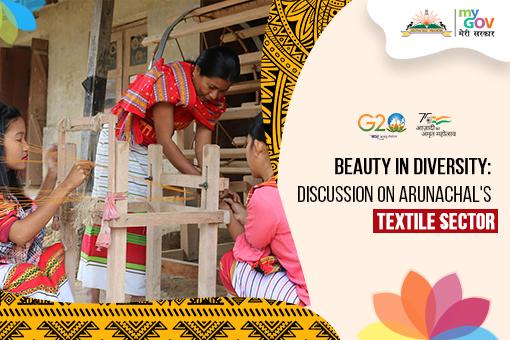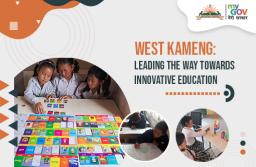Arunachal Pradesh traditionally known for its mesmerizing landscape is also home to a rich textile and handicraft industry. And because the state houses more than 20 major tribes and 100 sub-tribes, it is known for its diverse range of handloom and handicrafts, which are a reflection of the region's rich cultural heritage and traditional practices.
Handloom & Weaving: The handloom weaving industry is a significant source of employment in Arunachal Pradesh. The state is renowned for the excellent handmade textiles crafted by skilled weavers. The different tribes of Arunachal Pradesh weave using a variety of methods and designs to produce a wide range of textiles. Every tribe in the state has a distinctive weaving technique that is passed down from generation to generation. Each piece is distinctive and a testament to the weavers' abilities owing to the elaborate designs and patterns used in the weaving procedures.
The handloom weaving industry has enormous potential in Arunachal Pradesh, and many organizations and government bodies are working towards preserving and promoting this traditional craft. The state government has established a Handloom and Handicrafts Development Corporation to provide financial assistance, training, and marketing support to the weavers. The corporation also provides raw materials, looms, and other equipment to the weavers to create quality products.
Handicrafts: Arunachal Pradesh is also known for its diverse range of handicrafts, ranging from woodcarving to basketry. Each tribe in the state has its unique craftsmanship, creating beautiful products that showcase their traditional practices and cultural heritage. Some of the popular handicrafts of Arunachal Pradesh include bamboo and cane products, pottery, woodcarving, and beadwork. Pottery is another traditional craft that has been practiced in Arunachal Pradesh for generations. Woodcarving is a traditional craft that is practiced by many tribes in Arunachal Pradesh with beautiful patterns and beadwork is another popular craft in Arunachal Pradesh and is typically used to decorate clothes, bags, and jewelry.
Marketing and Export Opportunities:
Arunachal Pradesh's textile and handicraft industry has great potential to grow and expand. The state government has taken many initiatives to market and promote these crafts, particularly at the national and international levels, after realizing their full potential. The government has established several emporiums that sell these products and also participates in various trade fairs and exhibitions to showcase these crafts.
Furthermore, several NGOs and private organizations are working to create long-term employment opportunities for local artisans. These organizations train and empower artisans to produce high-quality goods while also assisting them in gaining access to markets.
MyGov Arunachal Pradesh invites citizens to share their valuable opinion and suggestions on how we can promote and market these local crafts to increase their reach and visibility.













BrahmDevYadav 2 years 5 months ago
How do we attract customers to buy clothes?
There are eight ways Retail Businesses can attract New Customers:-
1.Buy online, pick up in store.
2.Match online prices or value.
3.Provide inventory information online.
4.Send out promotions via SMS.
5.Optimize our website for local searches.
6.Host events.
7.Increase curb appeal.
8.Create a lounge space (with WiFi)
BrahmDevYadav 2 years 5 months ago
What is textile marketing?
Textile Marketing graduates develop a knowledge of the market research, product development, and sales functions of corporations producing fibers, yarns, fabrics and apparel and for interiors and industrial customers.
BrahmDevYadav 2 years 5 months ago
What are the four main textile processes?
PRODUCTION PROCESS:-
1. SPINNING:- Spinning allows the transformation of a mass of disordered fibres (staple) into
a unit of great length (yarn).
2. DYEING YARN:- Dyeing is the process of transforming greige (natural) yarn into coloured
yarn through the use of colour substances.
3. WEAVING.
4. FINISHING.
5. FINAL CHECKS.
BrahmDevYadav 2 years 5 months ago
How can we improve textile industry in India?
Thus to achieve growth in textile and apparel industry and to increasethe exports quality goods production and on time deliveries is a must and for quality goods production online monitoring of production process is amust and for on time deliveries to fulfill the commitments.
Santanu Datta 2 years 5 months ago
Coaporative approach with government share can boost textile industry.
ARUN KUMAR GUPTA 2 years 5 months ago
We cannot expect small handloom owner and artisan to buy various testing machines, there shall be some common testing centers where raw material's quality or final product can be tested for durability.
ARUN KUMAR GUPTA 2 years 5 months ago
We cannot expect small handloom owner and artisan to buy various testing machines, there shall be some common testing centers where raw material's quality or final product can be tested for durability.
ARUN KUMAR GUPTA 2 years 5 months ago
We cannot expect small handloom owner and artisan to buy various testing machines, there shall be some common testing centers where raw material's quality or final product can be tested for durability.
ARUN KUMAR GUPTA 2 years 5 months ago
We cannot expect small handloom owner and artisan to buy various testing machines, there shall be some common testing centers where raw material's quality or final product can be tested for durability.
ARUN KUMAR GUPTA 2 years 5 months ago
We cannot expect small handloom owner and artisan to buy various testing machines, there shall be some common testing centers where raw material's quality or final product can be tested for durability.